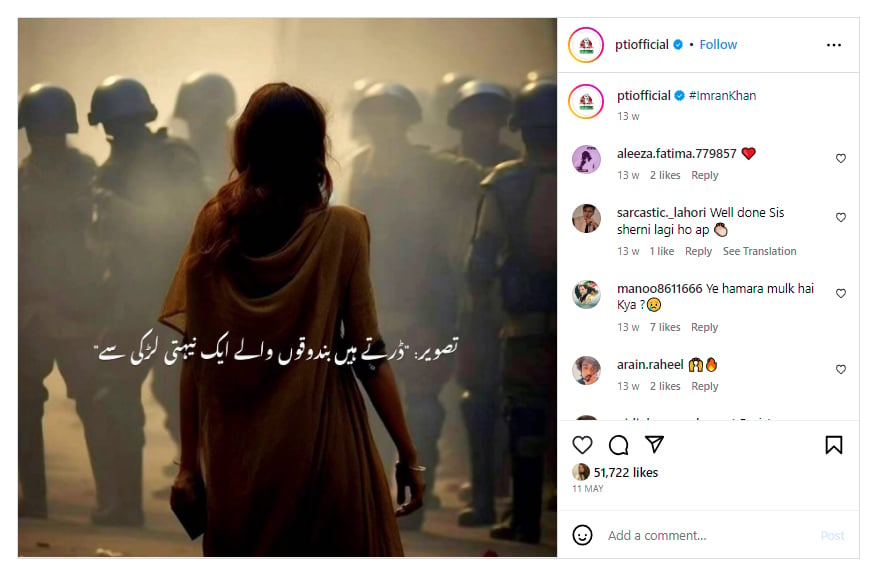AI: Boon for political propaganda and bane for fact-checkers in Pakistan
Technological advancements have made it near impossible for average social media user to tell real from fake content

As the race for Karachi mayoral election reached its peak and the rival political parties Pakistan Peoples Party (PPP) and Jamat-e-Islami (JI) fully geared up for the June 15 face-off, the Pakistani cyberspace once again witnessed dirty politicking on social media — rather than a disinformation campaign.
Karachi Stories — a pro-Jamat-e-Islami Facebook page with more than 100,000 followers — attacked PPP Chairman Bilawal Bhutto-Zardari with an AI-generated video, which sources confirmed to Geo.tv, was generated with Midjourney — a Discord-based AI platform.
Though not publicly linked to JI, the Karachi Stories social media account, according to sources, is run by people aligned with the party’s ideology and is being used by it to propel propaganda — a strategy used by political parties to use proxies to save themselves from blame.
The post shared on the said page titled "The Rise of Modern Fascism" shows half face of Bilawal Bhutto along with Adolf Hitler in a bid to label the Sindh-ruling party as a “Fascist Regime”.
This use of AI generative applications by Pakistani political parties is relatively new. It was first highlighted when supporters of the Pakistan Tehreek-e-Insaf (PTI), during May 9 violence, shared an image of a woman standing in defiance in front of riot police in Lahore — which later turned out to be AI-generated.
The same picture was also shared on the official Twitter account of PTI with the caption “Some pictures speak for themselves”.
In Pakistan, the proliferation of fake news on social media spiked as more and more political groups established their presence on digital platforms.
The rise of generative AI
Recent advancements in machine learning have massively changed the way deepfake videos and other multimedia content including imagery are produced at a massive scale falsely showing people saying and doing things they never said or did.
Technology has improved so much that it is almost impossible for an average social media user to differentiate between real and fabricated content.
With the accuracy and precision with which content is produced, it is becoming hard even for fact-checkers to point out despite advancements in tools to debunk fake information.
Echoing the alarm, Andy Carvin, Managing Editor and Senior Fellow at Digital Forensic Research Lab (DFRLab) said, “The release of ChatGPT and generative AI tools like Midjourney took the world by storm last year, and there’s plenty of concern that these tools will become part of the toolkit for bad actors engaging in disinformation, as well as other potential harms like fomenting political violence”.
Highlighting flaws like — ChatGPT’s quirky patterns of speech and Midjourney’s struggle to create accurate human hands — that can be used to detect AI-generated content, Carvin noted that “it’s only a matter of time before it becomes nearly impossible to tell the difference between what’s human-generated and what’s AI-generated”.
With the accuracy and precision of the content being produced, it is becoming hard even for fact-checkers to point out fake content despite advancements in tools to debunk fake information.
For example, the image of the woman that went viral during the May 9 protests makes a perfect case in this regard.
Angie Drobnic Holan, Director of International Fact-Checking Network — an affiliate of Poynter — told Geo.tv that these dynamics were very different from what came before, adding societies around the world were still grappling with how AI should be handled.
“It's hard to tell the potential for harm, but even AI experts have been sounding alarm bells.”
The first mover
In the first decade of the 21st century when social media was very new to Pakistani internet users, Imran Khan’s PTI established itself in this new arena.
PTI was the country’s first major political party to have created a Facebook account in 2009 while Pakistan Muslim League-Nawaz (PML-N) joined the social media in 2010. Pakistan Peoples’ Party (PPP) joined the fray in 2012.
This is not only about having a presence on social media what matters the most is its utilisation for narrative building which the PTI did to the fullest while its rival remained idle for many years before realising its true potential.
The party has always been held responsible for weaponising the platforms by launching campaigns against rivals and spreading disinformation.
However, it denies indulging in any such activity or encouraging its supporters for doing this.
Political analyst and journalist Mazhar Abbas shared that PTI took the lead in social media while other political parties followed suit.
“Initially, it used social media platforms for membership and fund collections. But with rising political polarisation and tension, PTI also took the lead in trolling and promoting negative trends.”
While political parties are blamed for abusing cyberspace, certain elements of the establishment are believed to have misused social media.
Senior journalist and political commentator Hamid Mir said, “Social media cells were established in the name of fifth-generation warfare where politicians and journalists who were not ready to take dictation from the powers that be were targeted”.
To counter the propaganda, Mir noted, political parties established their own cells and added that he had evidence that two of the major ruling partners [in the Shehbaz Sharif government] were also “involved in dirty propaganda”.
‘No’ to fake news
When asked to respond to allegations of spreading fake news, a PTI spokesperson categorically rejected this.
“Definitely not true,” Shahzaib Virk, who is a member of the party’s social media team and manages the main X account, told Geo.tv.
“Criticism is part of political discourse, I wouldn’t say that it’s ‘targeting opponents’ when one uses facts to counter fake news or propaganda."
While they understand the importance of being relevant in the era of information, both JI and PML-N blamed 'others' for running dirty trends.
Azma Bokhari, Secretary Information PML-N Punjab, held rival PTI for pushing trends against opponents. “This is PTI's trademark and they are the founder of the bad and vulgar hashtags.”
Responding to the query, JI spokesperson Shamsuddin Amjad said that they are aware of this and had always taught their workers to be mindful of their conduct on social media.
“We regularly conduct workshops for our members during which they are trained to maintain decorum.”
‘Piece of art’
The PTI spokesperson categorically rejected that they were using AI tools but termed the May 9 viral image a “piece of art”.
“The picture we are talking about was generated by a person on X — formerly Twitter — who has no link to PTI. It was a “piece of art” and art during fascism can be a great tool of information,” Virk added.

JI, on the other hand, admitted that they had “just started” using AI albeit on “a small scale which would increase with time”.
Amjad, however, clarified that Karachi Stories was not under the party’s social media team and works independently.
Online, offline
Michael Kugelman, a scholar of South Asian affairs at the Wilson Center, Washington, is of the view that social media has long been a galvanising force for PTI, and the party has leveraged its power like no other political party in Pakistan.
The US scholar also underscored the efficacy of the party’s communication strategy which he believed shaped the political environment in a big and often negative way, contributing to Pakistan’s polarisation.
Kugelman, however, noted that it would be an overstatement to link social media to the events of May 9 — the day when scores of enraged party workers attacked government and military installations during protests against their leader Imran Khan's arrest.
“The arrest of Khan and the violent protests that day played out in an ugly, highly charged political environment exacerbated by social media. But let’s be clear: Those events were triggered by factors offline.”
According to Kugleman, the party’s presence on digital platforms will benefit it in the upcoming elections massively but this advantage may be neutralised by the damage inflicted on PTI by a large and relentless state crackdown.
TikTok — the new weapon in fifth-gen warfare
Chinese short-video-sharing platform TikTok — which has seen a meteoric rise in Pakistan in the last couple of years and has been the most downloaded app in the country — will be under the microscope during the elections as it is becoming hugely popular here and becoming a town square replacing X (formerly Twitter) and Facebook.
In 2022, the video platform maintained its supremacy over Facebook with 39 million downloads while the Meta-owned app lagged behind by more than 7 million.
Imran Khan-led party is way ahead in TikTok usage.
Snapchat, on the other hand, ranked third on the list with nearly 30 million downloads showing a growth of 51.26% compared to 2021.
TikTok, which is a home for entertainment, is fast becoming a new battleground in Pakistan with the country’s two main political rivals — PTI and PML-N — fighting fiercely to gain space.
However, the Imran Khan-led party is way ahead.
The PTI spokesperson, when asked which social media platform — TikTok, Twitter, Facebook, Instagram, or Threads — is powerful in Pakistan, said “at this particular moment, we can definitely say TikTok.”
“Its reach in villages is extremely surprising. On the other hand, Twitter can be considered the premium tool through which we can put out information.”
The JI spokesperson agrees.
“Twitter is a powerful platform because of its elite use. After that, TikTok has a great influence among the people, especially the youth.”
Ensuring election integrity
The role of social media companies is vital when it comes to curbing disinformation and minimising threats to democracy by ensuring the veracity of elections.
The upcoming elections will be the first time unlike in 2013 and 2018, when PTI invested massively in this new battleground but now all the major political parties will be contesting with all guns blazing on social media.
“All political parties including mine are focusing on the next elections that would 60-70% take place on social media,” according to PML-N’s Bokhari.
TikTok’s election strategy entails collaborating with experts and government agencies.
In a statement to Geo.tv, a TikTok spokesperson shared that the company put together a comprehensive strategy regarding polls during US Elections 2020 which is implemented everywhere in the world and would be the same for Pakistan.
However, the official added that they will announce localised details once the elections are nearer in the country.
TikTok’s election strategy entails collaborating with experts and government agencies, refusing paid political advertisements, and releasing special product features.
“We are committed to combatting the spread of misinformation on the platform, including through supporting our community with education and authoritative information on important public topics like elections. Our goal is to help TikTok remain a place where authentic content thrives,” a statement on the company’s website said.
On the other hand, Meta shared that protecting the integrity of elections on its platforms was a priority and they have made investments in people and technology to strengthen this work over the past few years.
"Our goal is to give people a voice and help them participate in the civic process while reducing misinformation, combating hate speech, and election interference," a statement given to Geo.tv said.
Analysts, however, expressed concern about the growing trend of fake news.
Meta said that in line with their approach to global elections, they have a cross-functional working group dedicated to preparing for the upcoming election in Pakistan, and have also started providing resources and training for stakeholders on digital advocacy, community standards, online safety and political advertising.
Since 2017, the statement adds, the company has been involved in hundreds of elections and has built new products and developed stronger policies to stay ahead of emerging threats.
"We invest in artificial intelligence to improve our ability to detect violating content and keep people safe. These investments help us automate decisions on content so we can respond faster to emerging threats."
About WhatsApp, Meta said that they had a dedicated team to prevent abuse in three main areas including maintaining the private nature of messages, preventing coordinated misuse of apps and empowering users to counteract misinformation.
Thanks to its "best-in-class" spam detection technology, WhatsApp has banned mass messaging and spotted accounts engaging in abnormal behaviour. It also adds labels to forwarding messages and restricts the number of people to be sent messages.
Meanwhile, Google refused to comment on the matter.
Analysts, however, expressed concern about the growing trend of fake news.
“Social and digital media to me is uncontrollable,” Mazhar Abbas shared his disappointment, adding none among the three mainstream political parties tried to improve themselves when it comes to the use of highly abusive language.
“During elections, we may see a massive flow of disinformation and fake news.”
AI — ‘major challenge’ for fact-chekcers
Pakistani fact-checkers have also sounded alarm, saying imagery produced by AI tools is not easy to detect.
Benazir Shah, Geo Factcheck Editor, shared that identifying fake images generated by Artificial Intelligence tools was tricky and a major challenge for the fact-checkers at the moment.
Most fact-checkers are focusing on debunking AI-generated misinformation the way we would any other misinformation.
However, there are a few giveaways one can look out for when determining the authenticity of an image, she said.
“There are AI images which carry a very visible watermark. When there is no watermark, we, fact-checkers, use reverse image search tools to identify if the image in question has been indexed online or not.”
IFCN’s director Angie Drobnic Holan maintained that "currently, most fact-checkers are focusing on debunking AI-generated misinformation the way we would any other misinformation. We are also looking at ways that AI could be used to deploy fact-checking more effectively.”
Wasif Shakil is a staffer at Geo.tv
Data collection by Uswah Zahid, graphics and data visualisation by Afreen Mirza, and banner illustration by Aisha Nabi




